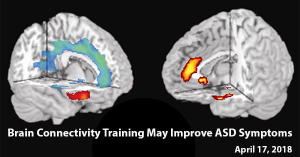Check out other stories from the Latest News
Neurofeedback Training Improves Brain Connectivity in People with ASD
By Chelsea Toledo, M.A. on April 17, 2018

Background: In recent years, researchers and clinicians have begun to leverage on brain imaging technology to provide “neurofeedback.” Through this process, they image the brain for aberrant activity and provide positive feedback when desired activity in that area is achieved. That positive feedback can take the form of a green light or another positive signal to participants.
What’s New: A recent study assessed the effectiveness of neurofeedback using functional magnetic resonance imaging, or fMRI, in young adult and adolescent males with ASD. The researchers conducted four training sessions over a period of eight days in 17 males with ASD, between the ages of 15 and 25, alongside 11 age-matched controls with typical development. Each training consisted of a series of “rest scans” with no task for the participant, along with a series of “puzzle tasks,” during which the participants attempted to reveal a hidden picture underneath a blank screen. When the participants exhibited the desired brain activity, positive feedback was given via revealing part of the picture and playing an upbeat sound.
The researchers found:
- The training resulted in improved connectivity in the whole brain, with the greatest differences observed in connectivity between two regions of interest, which previous research has linked to ASD. These changes were not found in the control group.
- The observed improvements in connectivity continued in subsequent “rest scans.”
- The improvements in brain connectivity correlated with improvements in the ASD participants’ behavior, as assessed by behavioral questionnaires filled out by parents before and after the series of trainings.
Why it’s important: This study provides further evidence of the role of brain connectivity in ASD. It also points to a potentially effective and non-invasive treatment option to address related behavioral issues. Larger studies including other participants (e.g., children and female groups) could further explore this possibility.
Help me understand :
| Source(s) : |
| Tweet |

